Radish is one of the best salad vegetables grown worldwide. Its green leaves are a rich source of vitamin A and can also be used as a green leafy vegetable. Radish can usually be grown all year round, but winter is best for good cultivation. Commercial Radish farming is a very common and popular business in many countries.
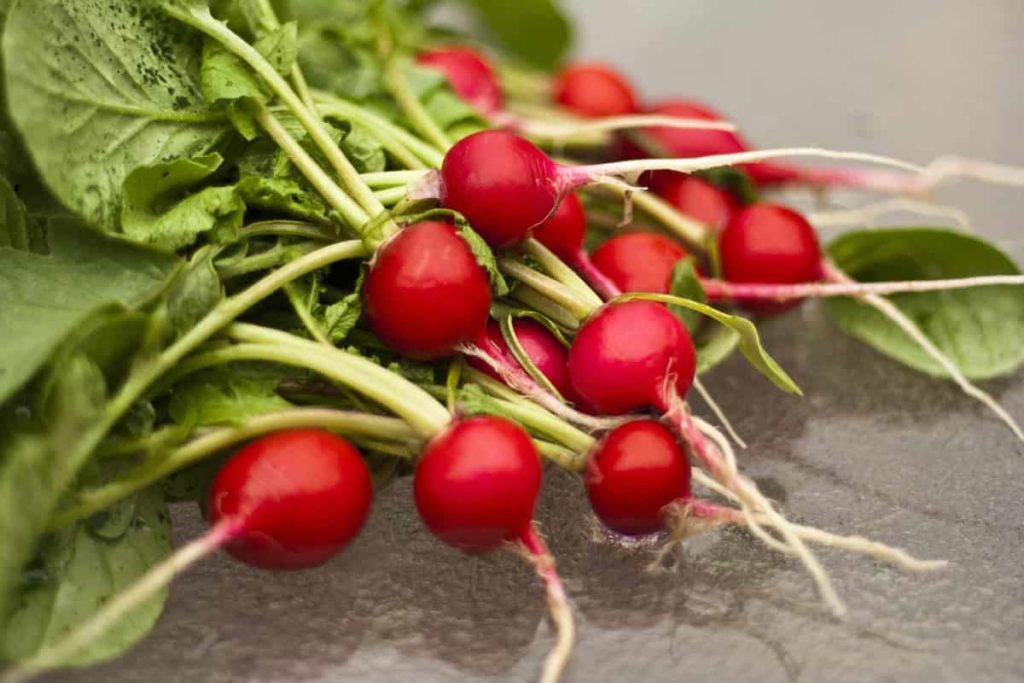
Radish is a significant crop grown almost everywhere in the world. Radish belongs to the member of the Cruciferae (mustard family). Belo steps are helpful to get a better yield of Radish. Let’s check out the steps/ways/methods to boost Radish yield below.
Steps/ways/methods to boost Radish yield
Step 1: Soil management for Radish growth
Radish can be grown on almost all types of soils, but the best results are obtained on light fox soils with high humus. Heavy soils produce rough, deformed roots that contain many small fibrous laterals and should be avoided. Radishes grow faster in hot weather. The roots stay in marketable condition only for a short time before becoming pithy. Growth should be steady and fast for good quality.
This crop requires a well-drained sandy loom with a good supply of organic matter. As well as providing moisture for good quality (light, soft and attractive). Rocky or gravelly soils are generally unacceptable, especially if bedding is used. Peat soils are suitable for the production of Radish. Root crops grow in pH ranges between 6 and 7 and use good amounts of phosphorus and moderate nitrogen. Excessive use of nitrogen fertilizers encourages top growth and sacrifices large, well-formed roots.
Because phosphorus does not travel easily into the soil, the zone from which your plants can absorb it is relatively small and close enough to the root, i.e., if a soil test indicates a need for phosphorus, it must be implemented side by side. Favorite sources of dressing organic phosphorus include rock phosphate and bone meal. Mulching is very important for maintaining soil moisture, and it will also help prevent weeds from the field. Use organic matter to use as mulching.
Step 2: Climate requirement to increase production
Radish is a cold-season crop, but Asian varieties can withstand more heat than European or temperate varieties. But Radishes get the best taste, texture, and size from 10 to 15°C. Long days and high temperatures cause bolting without proper formation of roots. In hot weather, the root becomes hard and sharp before it reaches edible size, so the crop should be harvested when it is young and small.
In case you missed it: Radish Gardening For Beginners – How To Start, FAQs
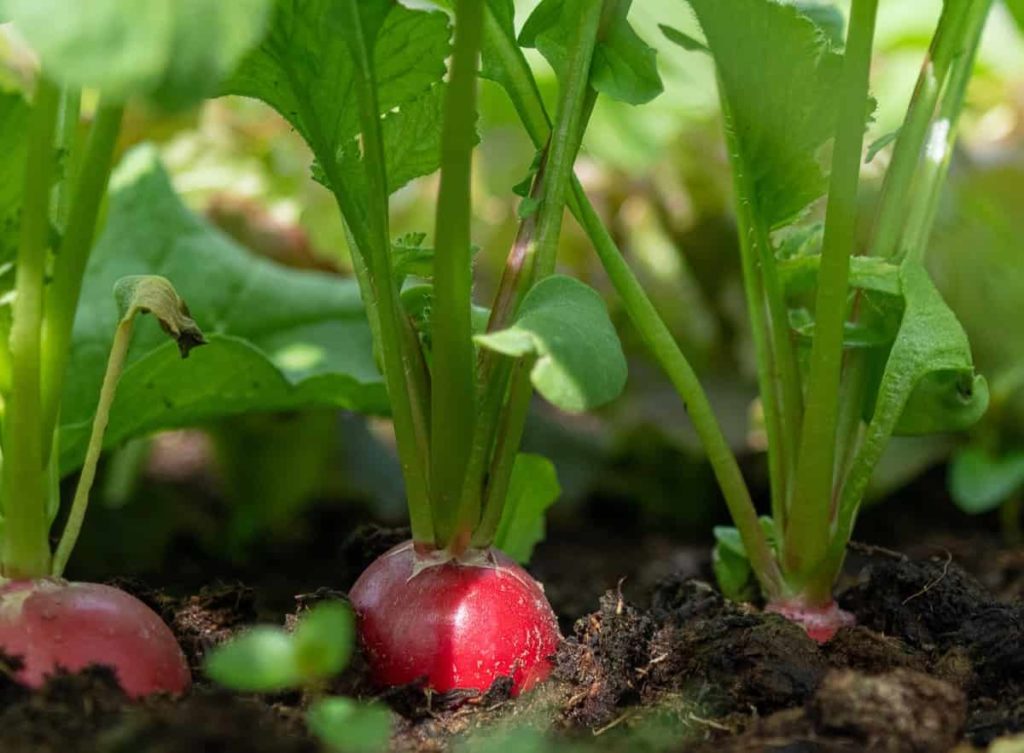
Step 3: Popular Radish varieties for getting more yield
The popular Radish varieties are Co1, Pusa Rashmi, Pusa Chetki, Pusa Desi, Japanese White, Arka Nishant, Butpee White, Champions, Cherry Belle, Daikon, Dragons Tail, French Breakfast, Misato Rose, Rat’s Tail, Red King, and Watermelon Radish. Some of the high yielding Radish varieties are;
Japanese White: The best time to sow is November-December. It was introduced in India from Japan. Late sowing is recommended in northern plains and sowing in July-September in hilly areas. The roots are cylindrical and pure white. Gives an average yield of 160 quintals per acre.
Pusa Chetki: The best time for sowing is April-August. The early ripening variety is suitable for seed production in the Punjab region. Its roots are smooth, snow-white, and of medium length. Its average yield is 105 quintal/acre, and seed production is 4.5 quintal/acre.
Pusa Himani: It is suitable for sowing in the fortnight of January-February. Its root is white with green shoulders. It is ready for harvest 60-65 days after sowing. Gives an average yield of 160 quintals per acre.
Punjab Pasand: The best time for sowing is from the second fortnight of March. It is an early maturing variety, ready for harvest 45 days after sowing. The roots are long, white, and hairless. Suitable for sowing in main season as well as off-season. In the main season, the average yield is 215 quintal/acre, while in the off-season, the average yield is 140 quintal/acre.
- Pusa Deshi: Suitable for sowing in Northern Plains. The roots are pure white. R
- Pusa Reshmi: The type is suitable for skin sowing.
- Arka Nishant: long and pink root type. It is ready for harvest in 50-55 days.
- Rapid Red White Tipped: A type of European table maturing quickly. Ready for harvesting in 25-30 days. The roots are small and bright red with pure white flesh.
Step 4: Sowing method for more growth
Radish is usually grown in heaps to facilitate good root production. It is grown as a crop or as a companion crop. Rows or tops of plants about 22 cm high are spaced about 45 cm apart, while plants are spaced 8 cm apart within the rows. European or moderate varieties, as they need close.
Step 5: Water requirement for Radish plant growth
Make sure they get enough rain or deep water. Drought stress can cause the roots to taste bad and have a hard texture. If planting doesn’t get an inch of rain every week, soak the soil well at least once a week. If soil is sandy, it is essential to water more than once a week. Radishes like moist soil ensure that the soil is never dry and always kept moist.
In case you missed it: Organic Radish Farming, Planting, And Growing Practices
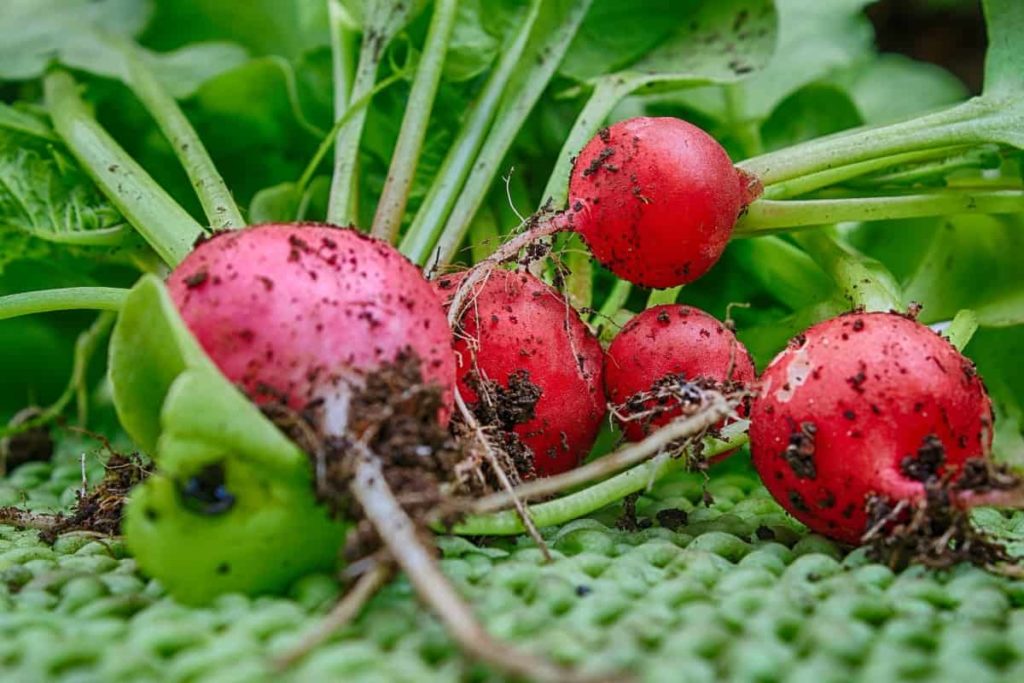
However, water moderately and avoid excess water to prevent the soil from overflowing. Water your Radish plants frequently and evenly. Failure to water your Radish plants frequently and evenly can make them a warm, woody flavor. You can use fertilizer to retain moisture. The use of fertilizers can be very effective.
Step 6: Manures and fertilizers affects the growth of Radish
Radish is a fast-growing crop, so the soil should be rich in plant nutrients. Apply 25-40 tons of agricultural fertilizer per hectare, 18-50 kg of nitrogen, 50 kg of ammonium sulfate, 50 kg of superphosphate, and 50 kg of potash in the form of mortise of potash. Radishes are root vegetables; fertilizer needs nutrients that promote root development without overly large leaves.
Farmyard manure should be well mixed during field preparation, while total potassium phosphate and half amount of nitrogen fertilizer can be applied in rows before sowing. Apply the remaining half of the nitrogen fertilizer as a top dressing with irrigation as the plants begin to grow fully. Nitrogen promotes the growth of green leaves, and although the environment is 78% nitrogen, plants cannot use this resource directly.
Microorganisms convert gaseous nitrogen into forms that plants can use during the fall process. These shapes are soluble and can come out of the soil quickly. When plants need nitrogen, they grow small, yellow, or colorless leaves and weak stems. Using a fish emulsion such as a high nitrogen fertilizer will give you many beautiful leaves in a short time, but your Radish roots may be small or completely reduced.
Phosphorus is essential for seed germination, root development, and fruit and seed arrangement. Deficiency may appear as stunted growth with purple on the leaves. It does not come out easily, so it stays in the soil for two to three years after planting. As a root vegetable, Radishes can benefit from fertilizers such as bone meal which is high in phosphorus. Bone meal contains calcium, another nutrient that promotes root growth.
Plants use potassium to make starch and sugar, which helps develop good-sized roots, disease resistance, and growth of flowers and fruits. Easily scorched leaves can easily indicate deficiency. Since potassium is very useful for growing large roots, it should be applied generously to early growing Radishes, usually in the form of 5-10-10 fertilizers – 5% nitrogen, 10% phosphorus, and 10% potassium.
Step 7: Why are your Radishes long and thin?
Radishes will grow taller and thinner due to hot weather, unsuitable soil, and competition with other plants. Too much nitrogen in the soil can also cause the Radishes to grow taller and thinner.
Step 8: Seed and seed treatment for plant growth
Depending on the type and variety, the number of Radish seeds is about 2,000-4,000 per ounce. Use warm water-treated seeds and fungicide treatment seeds to prevent many serious seed-borne diseases. Hot water seed treatments are very specific. Seed treatment is best done by a seed company and can usually be provided upon request.
In case you missed it: Radish Cultivation Income (Mullangi); Cost; Project Report
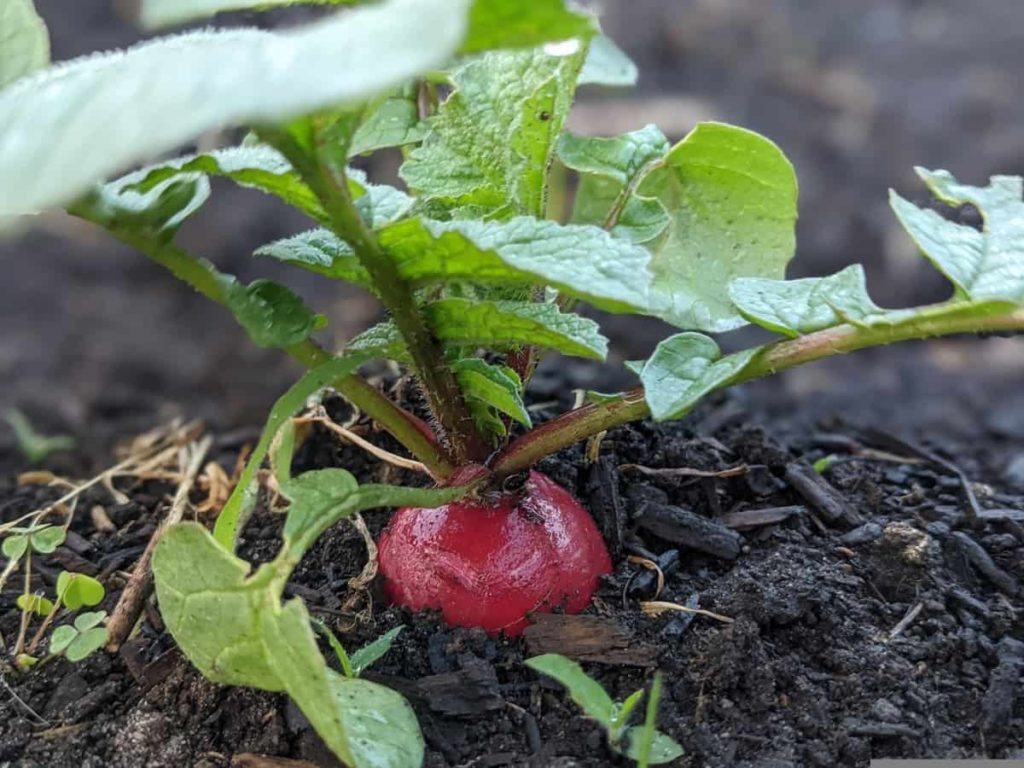
Step 9: Reasons for Radishes not forming and cracked Radishes
The lack of growth is due to planting too thick and not thinning 1 to 2 inches between plants. If the plants are so crowded on the bed that they are rubbing against each other, they will feel that there is not enough space to grow, so that they will go to seed. The Radishes split open as they mature and grow. Cracking is the result of uneven watering.
Trying to cover the drought with a lot of water at once will cause the Radish to grow very fast from the inside and split open. Make sure your Radishes regularly receive at least 1 inch of water each week. Split or cracked Radishes are often edible. If it’s just one or two cosmetic splits, you can still enjoy them in your salad – once they’re sliced, no one will notice the cracks.
Step 10: Tips for Radishes growing so slowly
Excess nitrogen and neutral acidity in the soil will also slow the formation of Radishes. A common reason for Radish bulbs not growing is overcrowding. Overcrowded Radishes do not have the room to make fleshy bulbs, so thinning to two inches (5 cm) can help promote bulb formation.
Step 11: Tips for Radish leaves yellow
Sometimes the leaves of Radishes turn yellow when they do not get enough sun. Radishes need six hours of full sun every day. It is fine if the Radishes have shade but need the sun to bloom.
Step 12: Weed control for more production
Also, to monitor the growth of weeds, perform intercultural operations such as weeding and hoeing to provide air to the soil. Two to three weeks after sowing, perform a weed operation. After the weeding, perform an earthing operation.
Step 13: Pests and diseases control of Radish for more growth
Due to the rapid growth of Radishes, the plant is relatively resistant to diseases. But it would help if you kept an eye on your Radish plants to ensure that insects like aphids or root maggots do not damage your crop. Aphids favor hot, dry conditions. Make sure your Radish plant gets enough water to keep aphids away.
If you see aphids, remove the affected leaves immediately. Root maggots are also a rare problem. These insects are present if you see something piercing your Radish crops. In this case, an organic pesticide is effective in treating root maggots. Weeds are the most common regarding Radish trouble, so keep a close eye on your garden beds and pull out whatever weed you see.
In case you missed it: Growing Radish In Containers Information
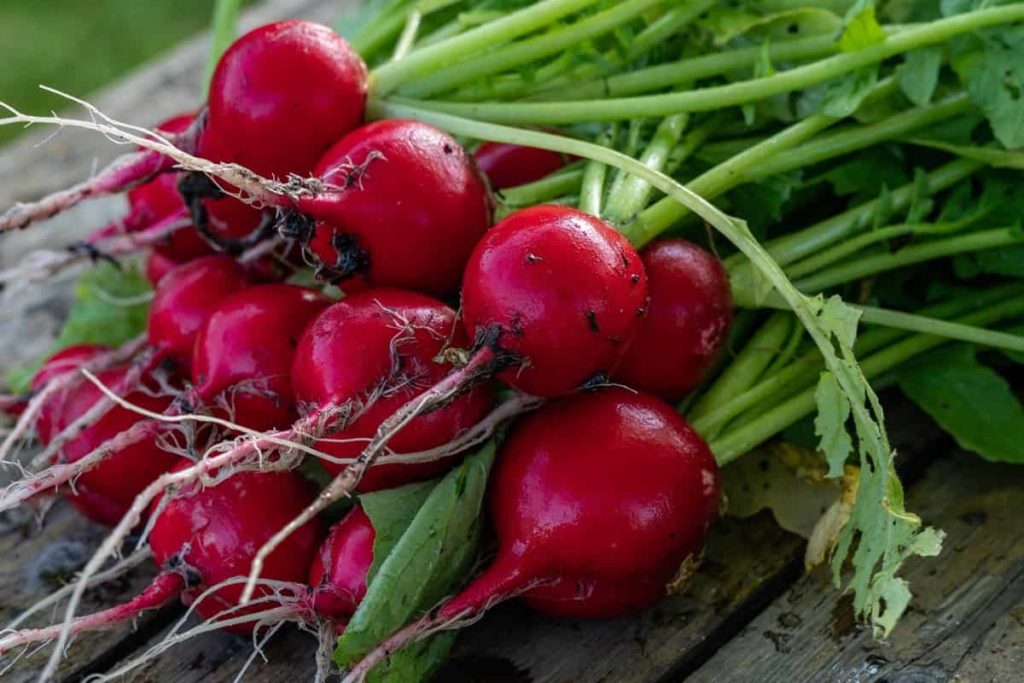
Although Radishes are generally free from pests and diseases, cabbage root maggot infections and clubroot problems have been reported. Aphids and root maggots can attack Radishes. Remove infected plants from the pinch. Generally, Radishes grow so fast that insects do not have a problem. Radishes do not have any serious diseases.
Step 14: Harvesting time for Radish growth and development
Note when your Radish variety should be ready for harvesting. Generally, harvest when the roots are about 1 inch in diameter. You have to take it out to see if it is ready. Harvest your Radish crop in a timely manner. Otherwise, you risk your Radishes exploding, cracking, or creating an unpleasant spongy texture and spicy taste.
Depending on the crop, the roots are ready for harvest about 25-35 days after sowing. Early and fast-maturing European crops reach maturity within 25-30 days of sowing. If harvesting is delayed, they become bitter and bitter.
In India, harvesting is done manually. Light irrigation can be given before harvesting to make the roots easier to lift. In developed countries, commercial Radish growers use a single row of harvester that pulls the plants out of the soil, cuts the roots from the top, then puts them in bags and takes them to the packing shed.
In case you missed it: Radish Farming; Planting; Care; Harvesting Guide
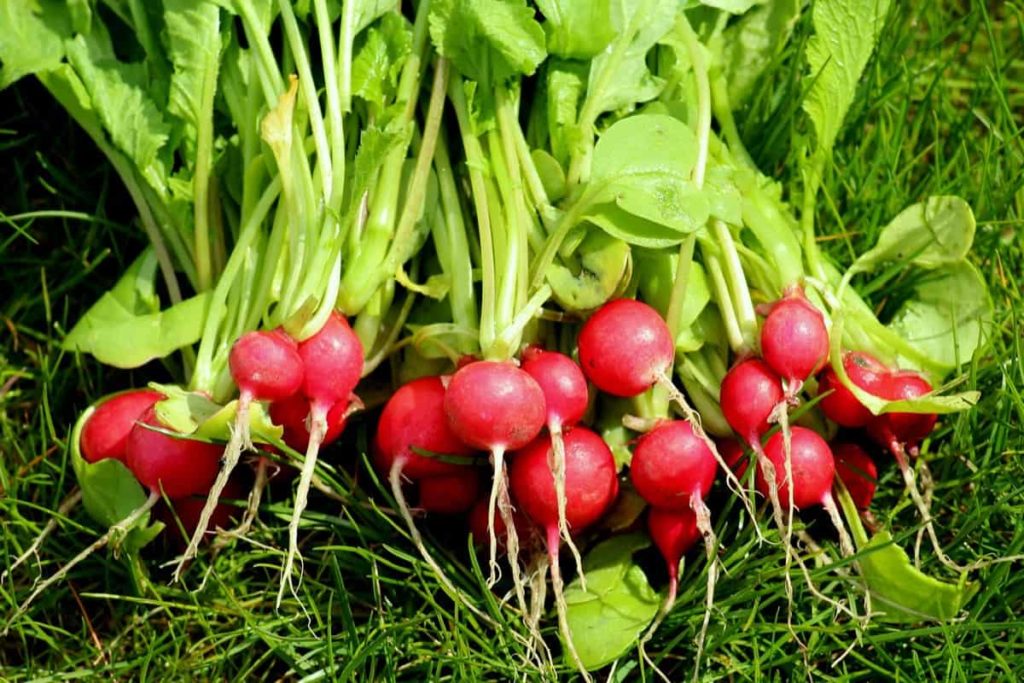
Step 15: Radish yield per acre
Yield per hectare depends on the variety and number of crops per year. Regular production of Radish is 10,000 to 15,000 kg per hectare. In the main season, the average yield is 215 quintal/acre, while in the off-season, the average yield is 140 quintal/acre.
- Economical Aquaculture: A Guide to Low-Budget Fish Farming
- 15 Common Planting Errors That Can Doom Your Fruit Trees
- How to Make Houseplants Bushy: Effective Tips and Ideas
- Innovative Strategies for Boosting Coconut Pollination and Yield
- Pollination Strategies for Maximum Pumpkin Yield
- The Complete Guide to Chicken Fattening: Strategies for Maximum Growth
- Natural Solutions for Tulip Problems: 100% Effective Remedies for Leaf and Bulb-Related Issues
- Revolutionizing Citrus Preservation: Towards a Healthier, Greener Future
- Natural Solutions for Peony Leaf and Flower Problems: 100% Effective Remedies
- Maximizing Profits with Avocado Contract Farming in India: A Comprehensive Guide
- Natural Solutions for Hydrangea Problems: 100% Effective Remedies for Leaf and Flowers
- The Ultimate Guide to Choosing the Perfect Foliage Friend: Bringing Life Indoors
- From Sunlight to Sustainability: 15 Ways to Use Solar Technology in Agriculture
- The Ultimate Guide to Dong Tao Chicken: Exploring from History to Raising
- The Eco-Friendly Makeover: How to Convert Your Unused Swimming Pool into a Fish Pond
- Mastering the Art of Delaware Chicken Farming: Essentials for Healthy Backyard Flocks
- 20 Best Homemade Fertilizers for Money Plant: DIY Recipes and Application Methods
- How to Craft a Comprehensive Free-Range Chicken Farming Business Plan
- Brighten Your Flock: Raising Easter Egger Chickens for Beauty and Bounty
- How to Optimize Your Poultry Egg Farm Business Plan with These Strategies
- Subsidy for Spirulina Cultivation: How Indian Government Schemes Encouraging Spirulina Farmers
- Ultimate Guide to Raising Dominique Chickens: Breeding, Feeding, Egg-Production, and Care
- Mastering the Art of Raising Jersey Giant Chickens: Care, Feeding, and More
- Ultimate Guide to Raising Legbar Chickens: Breeding, Farming Practices, Diet, Egg-Production
- How to Raise Welsummer Chickens: A Comprehensive Guide for Beginners
- How to Protect Indoor Plants in Winter: A Comprehensive Guide
- Ultimate Guide to Grow Bag Gardening: Tips, Tricks, and Planting Ideas for Urban Gardeners
- Guide to Lotus Cultivation: How to Propagate, Plant, Grow, Care, Cost, and Profit
- Agriculture Drone Subsidy Scheme: Government Kisan Subsidy, License, and How to Apply Online
- Ultimate Guide to Raising Araucana Chickens: Breed Profile, Farming Economics, Diet, and Care
- Bringing Hydroponics to Classroom: Importance, Benefits of Learning for School Students
- Ultimate Guide to Raising Polish Chickens: Breed Profile, Farming Economics, Diet, and Care
- Ultimate Guide to Raising Australorp Chickens: Profile, Farming Economics, Egg Production, Diet, and Care
- Silkie Chicken Farming: Raising Practices, Varieties, Egg Production, Diet, and Care
- Sussex Chicken Farming: Raising Practices, Varieties, Egg Production, Diet and Care
- Homemade Feed Formulations for Livestock: Discover Cost-effective Starter to Finisher Feed Recipes